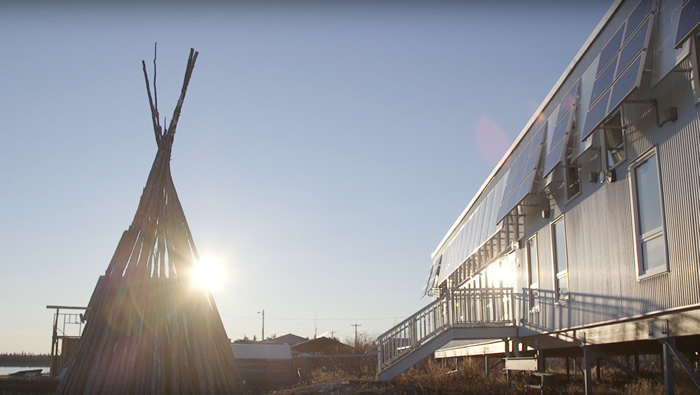 The remote Canadian village of Old Crow recently concluded a groundbreaking agreement with a local utility to sell the output of a 940 kW solar array. According to the arrangement between the Vuntut Gwitchin First Nation, which has its headquarters in Old Crow in the Yukon Territory, and ATCO Electric Yukon, the Vuntut Gwitchin government will own and operate the $6.5 million array over a 25-year contract period.
The remote Canadian village of Old Crow recently concluded a groundbreaking agreement with a local utility to sell the output of a 940 kW solar array. According to the arrangement between the Vuntut Gwitchin First Nation, which has its headquarters in Old Crow in the Yukon Territory, and ATCO Electric Yukon, the Vuntut Gwitchin government will own and operate the $6.5 million array over a 25-year contract period.
The Old Crow microgrid, which will also include batteries, diesel engines, and a microgrid controller, will be the largest solar project in the Yukon. It’s expected to offset the use of 190,000 liters of diesel per year, which is about a quarter of the annual diesel consumption in Old Crow for electricity generation, according to project consultant Dr. Alexandre Vigneault. During clear summer days, the community hopes that Old Crow can benefit from the midnight sun, operating for much of the 24-hour period on renewable energy. The project has the potential to provide economic opportunities and put the village of 250 residents on a path to sustainable development that reflects the indigenous values of the people who live there. Once the loans are paid off, the hybrid renewable investment should generate $400,000 a year for the community, according to Vuntut Gwitchin First Nation Chief Bruce Charlie.
 Traditional Values, New Technology
Traditional Values, New Technology
Old Crow is strategically placed to take advantage of the migration routes of the Porcupine Caribou herd, and for millennia, the people have relied on the herd for food, hide, and other necessities, co-existing symbiotically in the harsh northern environment with the caribou and other local wildlife. Located 80 miles north of the Arctic Circle, the village is the Yukon’s northernmost settlement, and it is strictly a “fly-in” community – no roads lead to Old Crow. In recent history, it has been entirely diesel-powered, and, heavy diesel fuel has to be shipped in by plane, an extremely expensive proposition.
Old Crow faced fuel shortages in 2017 after a crucial ice bridge failed to freeze early enough to bear traffic. The delayed bridge opening on the Dempster Highway meant that fuel had to be flown in from even further away than usual, considerably increasing the expense. Village residents are concerned that rising temperatures will create other unpredictable disruptions in their community.
Young Leaders in Old Crow Spearheaded Renewable Energy Planning
The Old Crow renewable energy project has been in the making for five years, according to Dana Tizya-Tramm, a councillor with the Vuntut Gwitchin Government. Its origins lie in concerns over climate change, and the determination of young village leaders to do something about it. Arctic settlements are at greater risk from climate change than communities at lower latitudes because temperatures are increasing more rapidly – and extremely – at the poles. Tizya-Tramm says the young people of Old Crow are determined to use new technology to protect the environment and lifestyles that mean so much to them. Along with his sister Erika, Dana and others their age began researching renewable energy potential in the far north, and the environmental and socioeconomic feasibility of a hybrid renewables project for Old Crow. They soon became experts and ultimately were able to bring the solar proposal to the local utility. (Learn more about the Old Crow renewable energy vision from this video).
 HOMER Pro Models Old Crow’s Unusual PV System Design, Adapted to Extreme Northern Climate
HOMER Pro Models Old Crow’s Unusual PV System Design, Adapted to Extreme Northern Climate
One of the things that the Old Crow leadership learned when they began to study the feasibility of renewable energy for their village was that solar was indeed possible. They learned that despite the long, dark winters, productivity of solar arrays during the shoulder seasons would be boosted by light refracted from the snow; in summer, when the northern sun never sets, Old Crow could go 100% renewable for much of the day on clear days. A Battery Energy Storage System (BESS) will be needed for backup power and to store excess solar energy production when the grid is 100% powered by solar.
Eventually, outside consultants joined the project to develop detailed engineering plans. They began using HOMER Pro to size the solar PV plant and determine the economic impact of other components in the system, such as batteries. In fact, Vigneault says HOMER Pro convinced him to increase the size of the solar array. Eventually, the team was able to demonstrate the technical and financial feasibility of the project, and they began negotiations to sell power to ATCO Electric Yukon.
Because of the challenges presented by a high wind load and fragile permafrost – upon which the large array would be built – the team came up with an unusual design, adapted to harsh northern conditions: instead of facing south, like most pole-mounted systems, the PV array would be set up as a tent-shaped structure, with panels facing east and west, coming together at the top. According to Vigneault, this will provide more structural support in a high-wind environment and allow longer daily energy production from the wide arc of the northern sun. Because of the unusual design, the inverters were sized with about half of the installed DC capacity, 480 kW AC vs 940 kW DC capacity.
 Foundations were designed using local knowledge to preserve the fragile permafrost, always at risk of melting as Arctic temperatures continue to rise. The foundations use insulation board, drainage pipes and locally available rock from the quarry. The racking will be anchored with a wire cable and duckbill system, minimizing ground penetration by metal structures and heat transfer to the permafrost.
Foundations were designed using local knowledge to preserve the fragile permafrost, always at risk of melting as Arctic temperatures continue to rise. The foundations use insulation board, drainage pipes and locally available rock from the quarry. The racking will be anchored with a wire cable and duckbill system, minimizing ground penetration by metal structures and heat transfer to the permafrost.
One other unusual accommodation will be made for the Old Crow PV array, which will be located along the Porcupine River on prime berry picking grounds. Some of the elder women in the village requested that berries be allowed to grow between the rows of panels. In a concession to indigenous traditions, that wish has been granted. The site will not be fenced and construction will avoid using machinery between the PV rows to preserve the berry patch. So the women (and perhaps also the local bears) will be able to harvest their berries while PV panels are harvesting energy from the sun.
Old Crow Solar Array To Be Built This Summer
Old Crow residents are eagerly awaiting construction of the solar array. which will begin with the foundation this July 2018. In 2019, the village will add battery storage to the system along with microgrid controls. Meanwhile, the same young leaders who have persisted with their vision of renewable energy will be looking into the prospects of adding small scale wind to their hybrid system. Ultimately their hope is to put Old Crow on a path that will allow them to produce most of their energy from renewable generation.
The Old Crow project will be featured as part of the Arctic track at the HOMER International Microgrid Conference this year October 8-10 in San Diego. Learn more at www.microgridconference.com.

Very nice article!!!
Cheers!!!
Thank you professor Professor Aung Ze Ya.